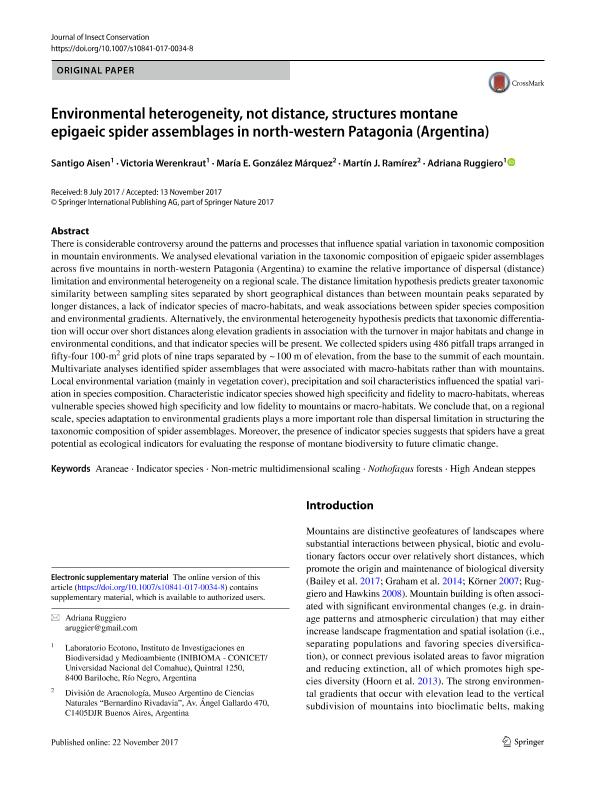Mostrar el registro sencillo del ítem
dc.contributor.author
Aisen, Santiago

dc.contributor.author
Werenkraut, Victoria

dc.contributor.author
González Márquez, María Eugenia

dc.contributor.author
Ramirez, Martin Javier

dc.contributor.author
Ruggiero, Adriana

dc.date.available
2018-11-13T19:05:00Z
dc.date.issued
2017-12
dc.identifier.citation
Aisen, Santiago; Werenkraut, Victoria; González Márquez, María Eugenia; Ramirez, Martin Javier; Ruggiero, Adriana; Environmental heterogeneity, not distance, structures montane epigaeic spider assemblages in north-western Patagonia (Argentina); Springer; Journal of Insect Conservation; 21; 5-6; 12-2017; 951-962
dc.identifier.issn
1366-638X
dc.identifier.uri
http://hdl.handle.net/11336/64386
dc.description.abstract
There is considerable controversy around the patterns and processes that influence spatial variation in taxonomic composition in mountain environments. We analysed elevational variation in the taxonomic composition of epigaeic spider assemblages across five mountains in north-western Patagonia (Argentina) to examine the relative importance of dispersal (distance) limitation and environmental heterogeneity on a regional scale. The distance limitation hypothesis predicts greater taxonomic similarity between sampling sites separated by short geographical distances than between mountain peaks separated by longer distances, a lack of indicator species of macro-habitats, and weak associations between spider species composition and environmental gradients. Alternatively, the environmental heterogeneity hypothesis predicts that taxonomic differentiation will occur over short distances along elevation gradients in association with the turnover in major habitats and change in environmental conditions, and that indicator species will be present. We collected spiders using 486 pitfall traps arranged in fifty-four 100-m2 grid plots of nine traps separated by ~ 100 m of elevation, from the base to the summit of each mountain. Multivariate analyses identified spider assemblages that were associated with macro-habitats rather than with mountains. Local environmental variation (mainly in vegetation cover), precipitation and soil characteristics influenced the spatial variation in species composition. Characteristic indicator species showed high specificity and fidelity to macro-habitats, whereas vulnerable species showed high specificity and low fidelity to mountains or macro-habitats. We conclude that, on a regional scale, species adaptation to environmental gradients plays a more important role than dispersal limitation in structuring the taxonomic composition of spider assemblages. Moreover, the presence of indicator species suggests that spiders have a great potential as ecological indicators for evaluating the response of montane biodiversity to future climatic change.
dc.format
application/pdf
dc.language.iso
eng
dc.publisher
Springer

dc.rights
info:eu-repo/semantics/openAccess
dc.rights.uri
https://creativecommons.org/licenses/by-nc-sa/2.5/ar/
dc.subject
Araneae
dc.subject
High Andean Steppes
dc.subject
Indicator Species
dc.subject
Non-Metric Multidimensional Scaling
dc.subject
Nothofagus Forests
dc.subject.classification
Otras Ciencias Biológicas

dc.subject.classification
Ciencias Biológicas

dc.subject.classification
CIENCIAS NATURALES Y EXACTAS

dc.title
Environmental heterogeneity, not distance, structures montane epigaeic spider assemblages in north-western Patagonia (Argentina)
dc.type
info:eu-repo/semantics/article
dc.type
info:ar-repo/semantics/artículo
dc.type
info:eu-repo/semantics/publishedVersion
dc.date.updated
2018-10-23T16:17:28Z
dc.identifier.eissn
1572-9753
dc.journal.volume
21
dc.journal.number
5-6
dc.journal.pagination
951-962
dc.journal.pais
Alemania

dc.journal.ciudad
Berlin
dc.description.fil
Fil: Aisen, Santiago. Consejo Nacional de Investigaciones Científicas y Técnicas. Centro Científico Tecnológico Conicet - Patagonia Norte. Instituto de Investigaciones en Biodiversidad y Medioambiente. Universidad Nacional del Comahue. Centro Regional Universidad Bariloche. Instituto de Investigaciones en Biodiversidad y Medioambiente; Argentina
dc.description.fil
Fil: Werenkraut, Victoria. Consejo Nacional de Investigaciones Científicas y Técnicas. Centro Científico Tecnológico Conicet - Patagonia Norte. Instituto de Investigaciones en Biodiversidad y Medioambiente. Universidad Nacional del Comahue. Centro Regional Universidad Bariloche. Instituto de Investigaciones en Biodiversidad y Medioambiente; Argentina
dc.description.fil
Fil: González Márquez, María Eugenia. Consejo Nacional de Investigaciones Científicas y Técnicas. Oficina de Coordinación Administrativa Parque Centenario. Museo Argentino de Ciencias Naturales “Bernardino Rivadavia”; Argentina
dc.description.fil
Fil: Ramirez, Martin Javier. Consejo Nacional de Investigaciones Científicas y Técnicas. Oficina de Coordinación Administrativa Parque Centenario. Museo Argentino de Ciencias Naturales “Bernardino Rivadavia”; Argentina
dc.description.fil
Fil: Ruggiero, Adriana. Consejo Nacional de Investigaciones Científicas y Técnicas. Centro Científico Tecnológico Conicet - Patagonia Norte. Instituto de Investigaciones en Biodiversidad y Medioambiente. Universidad Nacional del Comahue. Centro Regional Universidad Bariloche. Instituto de Investigaciones en Biodiversidad y Medioambiente; Argentina
dc.journal.title
Journal of Insect Conservation

dc.relation.alternativeid
info:eu-repo/semantics/altIdentifier/doi/http://dx.doi.org/10.1007/s10841-017-0034-8
dc.relation.alternativeid
info:eu-repo/semantics/altIdentifier/url/https://link.springer.com/article/10.1007%2Fs10841-017-0034-8
Archivos asociados
